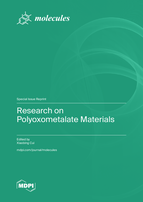Research on Polyoxometalate Materials
A special issue of Molecules (ISSN 1420-3049). This special issue belongs to the section "Applied Chemistry".
Deadline for manuscript submissions: closed (20 November 2022) | Viewed by 19501
Special Issue Editor
Interests: polyoxometalate; crystal structure; coordination compounds based on polyoxometalates; catalysis of polyoxometalates; electrode material based on polyoxometalates
Special Issue Information
Dear Colleagues,
Polyoxometalates (POMs) are a large and rapidly growing class of early transition metal oxide clusters. POMs are formed via acid-involved condensation reactions from monomeric oxometalate units, thus holding a special position (intermediate state) between monomeric oxometalate units and infinite metal oxide frameworks. Though the first compound of what we term a polyoxometalate was reported about two centuries ago by Berzelius (1826), POMs continue to show remarkable advances and unexpected surprises in both their fundamentals and applications. POMs exhibit a large diversity of structures including saturated structures such as the famous Keggin, Well–Dawson, Anderson, etc., and unsaturated structures such as the vacant Keggin, vacant Well–Dawson, etc. Especially, the unsaturated POMs can act as robust and pure inorganic ligands to coordinate with almost all the transition metals, and then be integrated into the frameworks of POM clusters. The chemical compositions of POMs are mainly Mo, W, V, Nb and Ta. The heteroatom of POMs are more variable, including P, As, B, Al, Si, Ge, S, and so on. It is well known that there is a general correlation between the complexity of the structure of a compound and the functionality that it displays. The wide range of chemical composition variability and a large amount of unusual structural types of POMs can thus exhibit a large number of different properties such as rich solution equilibria, significant chemical and thermal stability, strong acidity, and the ability to act as proton–electron sinks due to their fast and reversible proton-coupled redox processes. Virtually all of the molecular properties of these POMs can be altered by fine-tuning the structure and chemical composition of the POMs at the atomic level. Based on their intrinsic multifunctional nature, POMs have significant applications in catalysis, medicine, and materials science, etc. POMs can not only be used widely in different disciplines, but can also be combined with polymers, oxides, ionic liquids or carbonaceous supports to construct new and advanced composite (hybrid) materials, which have important, extensive applications in catalysis, electrode materials, electrocatalysis, photocatalysis and so on. This Special Issue focuses on the fundamentals of POMs and POM-based materials, including synthetic methods, reactivity, spectroscopic or spectrometric studies, structures, mechanistic insights and DFT calculations, and potential applications, such as redox- and acid-base catalysis, photo- and electrochemistry, magnetism, electronics, optics, bio-medicine, energy conversion and storage, sorption and separation, environmental remediation and medicine. Full papers, communications, and reviews on these topics are welcome.
Dr. Xiaobing Cui
Guest Editor
Manuscript Submission Information
Manuscripts should be submitted online at www.mdpi.com by registering and logging in to this website. Once you are registered, click here to go to the submission form. Manuscripts can be submitted until the deadline. All submissions that pass pre-check are peer-reviewed. Accepted papers will be published continuously in the journal (as soon as accepted) and will be listed together on the special issue website. Research articles, review articles as well as short communications are invited. For planned papers, a title and short abstract (about 100 words) can be sent to the Editorial Office for announcement on this website.
Submitted manuscripts should not have been published previously, nor be under consideration for publication elsewhere (except conference proceedings papers). All manuscripts are thoroughly refereed through a single-blind peer-review process. A guide for authors and other relevant information for submission of manuscripts is available on the Instructions for Authors page. Molecules is an international peer-reviewed open access semimonthly journal published by MDPI.
Please visit the Instructions for Authors page before submitting a manuscript. The Article Processing Charge (APC) for publication in this open access journal is 2700 CHF (Swiss Francs). Submitted papers should be well formatted and use good English. Authors may use MDPI's English editing service prior to publication or during author revisions.
Keywords
- polyoxometalate
- crystal materials of polyoxometalates
- coordination compounds based on polyoxometalates
- catalysis of polyoxometalates
- electrode material based on polyoxometalates
- DFT calculations of polyoxometalates
- composites based on polyoxometalates







